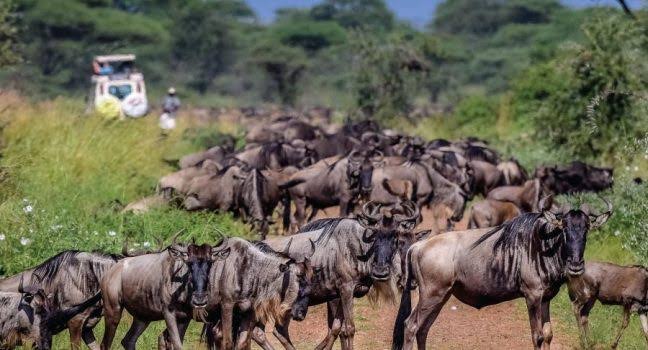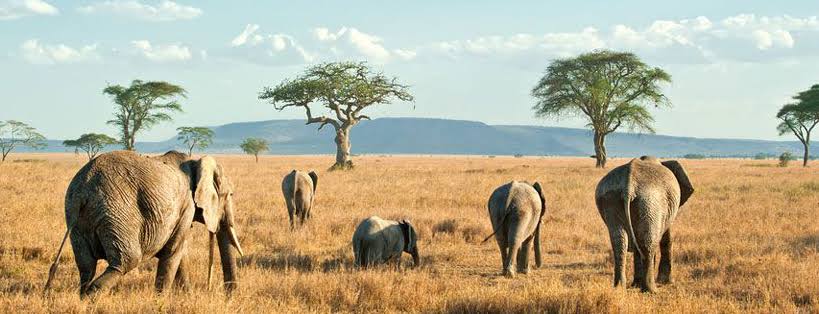
Serengeti National Park Northern part
Serengeti National Park Northern part
Serengeti National Park Northern part is one of the top-visited areas in the park which has quite a number of wildlife species. Serengeti national park is a safari destination which is located in the northern part of Tanzania. This national park is made up of different parts or sectors which can be visited and explored by tourists all year round.
The northern part of Serengeti national park is also known as the Lobo area. This part of the national park is found close to the Masai Mara national reserve in Kenya. It is among the least visited parts of Serengeti national park.
Serengeti national park is generally known for its good wildlife viewing opportunities and this can be seen in its different parts such as the northern part of Serengeti national park which has a great concentration of elephants.
The northern part of Serengeti national park is characterized by green rolling hills, acacia woodland, a granite outcrop, open savannah which acts as a habitat for the various wildlife and bird species which can be seen roaming and grazing in the national park.
The Lobo valley is found in the northern part of the Serengeti national park. This valley has beautiful scenery, the second-largest lion pride in Serengeti national park, a large concentration of elephants as well as a variety of wildlife species.
The Mara River is also found in the northern part of Serengeti national park and is known for being the main crossing point of the wildebeest during the great wildebeest migration from July to September.
Other parts of Serengeti national park which can be visited by tourists for exploring the different attractions and to engage in activities such as wildlife viewing among others include;
- The Western part of Serengeti national park consists of the Grumeti river, a dense bush and forest. Herds of wildebeest can be seen in this part of the national park during the months of April, May, June and in July.
During the wildebeest migration in this part of Serengeti national park other wildlife species such as zebras, impalas and elands can be seen grazing among the wildebeest which can be seen crossing the river which is infested with crocodiles as the wildebeest search for greener pastures and water.
Tourists can also stay at the various accommodation facilities which are found in the western part of Serengeti national park to enjoy the beautiful scenery and to see the different attractions within the national park.
- The Southern part of Serengeti national park stretches from the Seronera area to the Ngorongoro conservation area and Maswa reserve. This part of the national park is characterized by grassy plains and granite kopjes.
During the months of December and May, tourists can see the wildebeest migration from the southern sections of the national park. the calving season for the wildebeest can also be witnessed during the month of February in this part of Serengeti national park.
Tourists can also drive off track in this part of Serengeti national park as they search for the different wildlife species and other attractions within the national park. Other activities that take place in the southern part of the national park include walking safaris, hot air ballooning among others.
- The Central part of Serengeti national park is also known as the Seronera area after the Seronera valley. Seronera area boasts of a variety of wildlife species and is characterized by dotted trees such as acacia trees and grass plains.
This part of Serengeti national park is famous among tourists and it has a high concentration of big cats such as lions, leopards, cheetahs. It is characterized by rocky outcrops, rivers, swamps, and grasslands which act as habitat for the wildlife.
The central part of Serengeti national park is recommended for wildlife viewing and other activities at its best during the months of April to June. Tourists can watch the wildebeest migration from different spots within the national park such as the Seronera valley, Moru kopjes, Simba kopjes, and Masai kopjes.
Best time to visit the northern part of Serengeti national park
Tourists can visit the Serengeti national park all year round and the recommended time of year to visit the northern part of the national park is during the months of June to October when tourists can also experience the wildebeest cross the Mara River.
Activities in the northern part of Serengeti national park include the following;
- Game drives are among the wildlife viewing activities which take place in Serengeti national park and they occur at different times of the day such as in the morning, in the evening and full day game drives. During morning game drives, tourists can see many wildlife species since they are more active during this time of day. Full day game drives involve watching the wildlife species such as elephants, lions, leopards, rhinos, buffalos, giraffes, waterbucks, wildebeest, hartebeest, hyenas, antelopes, zebras among others at different times of day as they graze and roam around in the national park.
- Birding involves tourists watching the different bird species within the national park such as secretary birds, grey breasted spurfowl, rufous tailed weaver, fishers love bird, kori bustard, yellow throated sand grouse among others. Birding can be best done during the months of November to April when both migratory and native birds are present.
- Community visits engage tourists in interacting with the local community which inhabits the Serengeti national park who are the Maasai people. During the community visits, tourists can engage in different activities such as watching cultural dances, seeing local arts and crafts of the Maasai such as beaded jewelry, visiting the “manyattas” which are the Maasai traditional homesteads, listening to folk tales, getting to know more about the way of life of the Maasai and so much more.
- Hot air ballooning is a unique way of wildlife viewing in Serengeti national park which provides an aerial view of the rest of the national park and the different attractions such as wildlife species.
- Nature walks in the northern part of Serengeti national park take place in different location such as around Kogatende near the Mara river. This provides tourists with a unique way to explore the wilderness of the national park and to see the scenery. Nature walks also involve spending hours on foot in the bush with a guide as tourists explore the small details in the national park such as plant species.
Attractions which can be seen in the northern and other parts of Serengeti national park include the following;
- The wildebeest migration is among the major attractions in Serengeti national park which involves movement of large herds of wildebeest between Masai Mara national reserve and this national park at different times of the year. The crossing in the northern part of this national park takes place along the Mara River.
- Wildlife and bird species can be seen during the many wildlife viewing activities which take place in the northern part of Serengeti national park. The wildlife species include the big five such as elephants, buffalos, rhinos, leopards, lions and other wildlife species include cheetahs, antelopes, oribis, kobs, hippos, giraffes, wildebeest, kudu, hartebeest among others.

- Maasai people can be seen by tourists visiting the Serengeti national park and they are known for their unique culture and nomadic way of life. Tourists interact with the tourists to let them know more about the Maasai way of life such as their traditions, customs and norms, cultural dances and other traditional ceremonies, local arts and crafts such as beaded jewelry, listening to folk stories and many other cultural activities of the Maasai.
- Olduvai gorge is an archaeological site which is found in the eastern part of the Serengeti national park which explains the finding of human remains and other relics which explain the existence of human life in the earlier centuries. This site was discovered by Mary and Louis Leakey who developed different excavation and research programs at this site. Some of the discoveries at the site include stone tools and animal remains.
- Moru kopjes act as look out points for lions and other predators in Serengeti national park. These kopjes are made up of granite rock outcrops and is also the location where black rhinos can be spotted in Serengeti national park. Close to the Moru kopjes is the Lake Magadi where a large number of flamingos can be seen along the shores of the lake. Other wildlife species which can be seen at the Moru kopjes include waterbucks, lions, leopards, elephants, rock hyrax, impalas, buffalos and topis.
- Retina hippo pool is a pool within Serengeti national park where many hippos can be seen bathing and swimming. This pool is located in the northern part of Seronera where the Seronera river meets the Orangi river. Tourists can also get an experience of leaving the comfort of their vehicles to get a good view of the hippos at this point. There is also a picnic point where tourists can enjoy the scenery while sharing meals with their loved ones in the wilderness of the national park.
- Grumeti river is another location in the western part of Serengeti national park which is crossing point for wildebeest during the great wildebeest migration during the months between May and July. This part of Serengeti national park is characterized by open savannah, woodlands, savannah plains, floodplains and a riverine forest. Wildlife species that can be seen around the Grumeti river include elephants, zebras, giraffes, colobus monkeys, Nile crocodiles, and hippos.
- Seronera river valley is another point of interest in the Serengeti national park which provides amazing wildlife viewing opportunities for tourists.
Discover the beauty of the northern part of Serengeti national park and explore the rest of the national park in search of wildlife species and other attractions in the national park.


